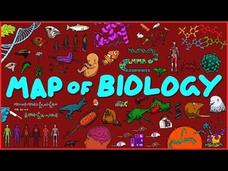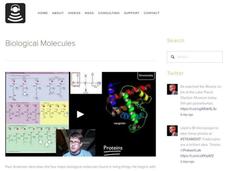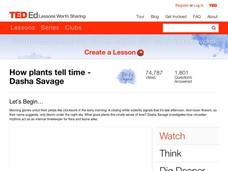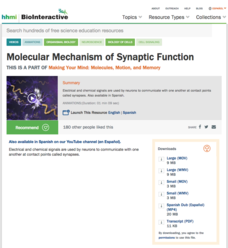The Wall Street Journal
Paging Dr. Machine
Will artificial intelligence and machine learning reshape the way diagnostics and other medicine are conducted?
Catalyst University
Tryptophan Conversion to Aminocarboxymuconate Semialdehyde
Part 1 of Tryptophan Degradation by the Liver
Catalyst University
Human Sulfur Metabolism (Part 1): Hydrogen Sulfide and Atomic Sulfur!
Human Sulfur Metabolism (Part 1): Hydrogen Sulfide and Atomic Sulfur!
Catalyst University
Phenylalanine, Tyrosine Catabolism to Acetoacetate
Phenylalanine, Tyrosine Catabolism to Acetoacetate
Catalyst University
Catecholamine Biosynthesis from Tyrosine
Catecholamine Biosynthesis from Tyrosine
Professor Dave Explains
Cholera Vibrio cholerae O1 and O139
What is cholera exactly? Believe it or not, this disease isn't gone, it's still an issue in various parts of the world. It's caused by Vibrio cholerae, and in particular two serotypes of this bacterium. Let's get some details!
Catalyst University
Nitric Oxide Synthase: Physiology, Biochemistry, and Mechanism
Nitric Oxide Synthase: Physiology, Biochemistry, and Mechanism
Curated Video
Exploring Carbohydrates
Exploring Carbohydrates identifies the primary functions of carbohydrates by describing how carbohydrates are used as a structural component, for energy storage, and as a source of energy in living organisms.
Bozeman Science
Molecular Biology
Explore the bacteria at Yellowstone to introduce molecular biology. Scholars learn about the process of genetic engineering and how it has progressed over time, including the identification of the breast cancer genes and the main...
Domain of Science
The Map of Biology
Many define biology as the study of life but can't agree on a definition of life. Trying to explain all of the domains and subdomains of biology seems a bit easier than defining life. See a full map of the topics covered by the general...
American Chemical Society
The Nobel Prize in Chemistry: Molecular Machines, Explained
What does it take to win a Nobel Prize? Scholars learn about molecular machines, the theme of the 2016 Nobel Prize in Chemistry. It explains how the three winners have each contributed to this field of science.
Howard Hughes Medical Institute
Molecular Basis of Late Ltp (Long-Term Memory)
Scholars compare and contrast the molecular changes for short-term and long term-memory with the help of animated videos. Viewers see the chemical process that changes the brain and stores memories thanks to dopamine.
Bozeman Science
Biological Molecules
Focus on macro-molecules including nucleic acids, proteins, lipids, and carbohydrates. A video explains which are monomers, which form polymers, and the process of changing from one to the other. It also covers the characteristics of...
Bozeman Science
The Origin of Life - Scientific Evidence
Guess where the oldest rocks on Earth are found? And what do these rocks reveal about the age of the earth? Viewers of this short video analyze the age of the earth and explore the origin of life through geologic, chemical, and...
Howard Hughes Medical Institute
Molecular Basis of Early Ltp (Short-Term Memory)
Digital amnesia: forgetting information one easily finds online. Learn how our brains move information into short-term memory at the molecular level with a short animation sure to make a memorable impression. Viewers observe a synapse...
Howard Hughes Medical Institute
The Mammalian Molecular Clock Model
Animals don't read clocks, so how do they know when it is time for eating, sleeping, and other cyclical needs? Viewers watch an animation of the genes and the molecular clocks inside most mammals. They compare the difference in wild...
TED-Ed
How Plants Tell Time
Can someone really have a "biological clock"? Discover why many organisms on earth have an inherent awareness of where they are in the day's cycle.This video discusses animal adaptations, the earth's revolutions, and how light and...
TED-Ed
Self-Assembly: The Power of Organizing the Unorganized
What if buildings could grow, adapt, and repair themselves like a living organism? Using the process of self-assembly, this crazy idea may one day become a reality. The video looks at how unordered parts interact with one another and...
Howard Hughes Medical Institute
Molecular Mechanism of Synaptic Function
Neurons don't touch each other, but they still communicate. Observe the process of both electrical and chemical signals used by neurons to share information. Hear exactly what triggers each step of the reaction as you view an animation...
Howard Hughes Medical Institute
The Origin of Species: The Making of a Theory
The heartbreaking story of Alfred Wallace's loss of collected evidence opens this documentary about the development of the theory of evolution. You will find supportive resources to use with the movie in your biology class.
Howard Hughes Medical Institute
The Molecular Cascade in Bacterial Quorum Sensing
Antibiotics kill bacterial growth, but widespread use results in antibiotic resistance. Researchers wonder if quorum sensing might allow us to treat bacteria without the resistance. View an animation of quorum sensing as it regulates...
Curated OER
Human Genome
Welcome to the complex biological story that is our life. Great visual imagery zooms in on the dissection of a DNA double helix in our body. What happens with RNA? Where do amino acids come in? This resource explores our inner workings...
Howard Hughes Medical Institute
Molecular Activity in Aplysia Short-Term Memory
Scientists have yet to find the limit on the human brain's capacity for memory storage, so the potential is limitless! An animated video demonstrates how the brain places information in short-term memory. Viewers observe the importance...
Other popular searches
- Cell and Molecular Biology
- History of Molecular Biology
- Molecular Biology Software
- Molecular Biology Models
- Molecular Biology Organic
- Evolutionary Molecular Biology
- Molecular Biology of Gene
- Cellular Molecular Biology
- Molecular Biology Vido
- Molecular Biology Vi Do
- Cellular and Molecular Biology
- Molecular Biology Video

















